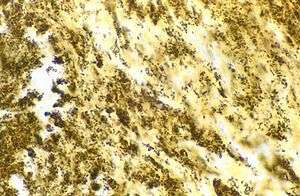Bartonella henselae
Bartonella henselae, formerly Rochalimæa, is a proteobacterium that is the causative agent of cat-scratch disease[1] (bartonellosis).
| Bartonella henselae | |
|---|---|
 | |
| Scientific classification | |
| Domain: | Bacteria |
| Phylum: | |
| Class: | |
| Order: | |
| Family: | |
| Genus: | |
| Species: | B. henselae |
| Binomial name | |
| Bartonella henselae (Regnery et al. 1992) | |
Bartonella henselaeis a member of the genus Bartonella, one of the most common types of bacteria in the world. It is a facultative intracellular microbe that targets red blood cells. One study showed they invaded the mature blood cells of humans.[2] It infects the host cell by sticking to it using trimeric autotransporter adhesins.[3] In the United States about 22,000 people are diagnosed, most under the age of twenty-years-old. Most often it is transmitted from kittens, boys are more at risk because they are more likely to play rough and get scratched. [4]
Diagnosis
B. henselae is a Gram-negative rod.[5][6] It can be cultured in a lysis-centrifugation blood culture.[7] The presence of bacteria can be detected by Warthin-Starry stain, or by a similar silver stain technique performed on infected tissue.
The specific name henselae honors Diane Marie Hensel (b. 1953), a clinical microbiology technologist at University of Oklahoma Health Sciences Center, who collected numerous strains and samples of the infective agent during an outbreak in Oklahoma in 1985.[8]
Symptoms
B. henselae infection can appear up to ten days after exposure to the microbe. Symptoms start with a papule at the site the microbe enters, followed by lymphadenopathy, usually in the axillary node. Half of patients also get aches, nausea, abdominal pain, and malaise. [9] There are a lot of other complications that this microbe can cause beyond the typical fever, lymphadenopathy, and general malaise. Immunocompromised people or patients that already have other conditions are at greater risk for further complications. Some cases have been found in children that had previous heart valve disease, these children got endocarditis from B. henselae infection. Some patients had hepatosplenic involvement, myalgia, and arthritis after exposure to B. henselae. [10] In rare cases osteomyelitis, an infection in the bone, can be a manifestation of B. henselae. [11]
Treatment
There is no definite treatment regimen for a patient infected with B. henselae. Treatment depends on the wide range of symptoms that present. In most cases it will resolve on its own in 4-6 weeks.[12] Aminoglycosides in lab tests showed some bactericidal activity. Bacteriostatic antibiotics aren’t able to easily get through to intracellular Bartonella so they aren’t recommended. In immunocompromised patients pain medication is often prescribed. Nodes may need to be aspirated if painful, micro-abscesses often form, the abscess needs to be aspirated in many places to remove all the exudate. Because of chronic sinus tract formation risks, the nodes should not be incised to be drained. Azithromycin can be used for lymphadenopathy, which is enlarged or swollen lymphnodes.. [13]
See also
- BH11960
References
- Jerris RC, Regnery RL (1996). "Will the real agent of cat-scratch disease please stand up?". Annu. Rev. Microbiol. 50: 707–25. doi:10.1146/annurev.micro.50.1.707. PMID 8905096.
- Cotté, Violaine, et al. "Transmission of Bartonella henselae by Ixodes ricinus." Emerging infectious diseases 14.7 (2008): 1074.
- Angelakis E, Raoult D. Pathogenicity and treatment of Bartonella infections. Int J Antimicrob Agents 2014;44:16–25.
- Zangwill, Kenneth M., et al. "Cat Scratch Disease in Connecticut--Epidemiology, Risk Factors, and Evaluation of a New Diagnostic Test." New England Journal of Medicine329.1 (1993): 8-13.
- Angelakis E, Raoult D. Pathogenicity and treatment of Bartonella infections. Int J Antimicrob Agents 2014;44:16–25.
- Kavita Diddi; Rama Chaudhry; Nidhi Sharma; Benu Dhawan (28 March 2011). "Strategy for identification & characterization of Bartonella henselae with conventional & molecular methods". Indian Journal of Medical Research. 137 (2): 380–387. PMC 3657863. PMID 23563383.
- Bernard La Scola; Didier Raoult (17 March 1999). "Culture of Bartonella quintana and Bartonella henselae from Human Samples: a 5-Year Experience (1993 to 1998)". Journal of Clinical Microbiology. 37 (6): 1899–1905. PMC 84980. PMID 10325344.
- Parte, A.C. "Bartonella". www.bacterio.net.
- Mazur-Melewska, Katarzyna, et al. "Cat-scratch disease: a wide spectrum of clinical pictures." Advances in Dermatology and Allergology/Postȩpy Dermatologii i Alergologii 32.3 (2015): 216.
- Mazur-Melewska, Katarzyna, et al. "Cat-scratch disease: a wide spectrum of clinical pictures." Advances in Dermatology and Allergology/Postȩpy Dermatologii i Alergologii 32.3 (2015): 216.
- Pitassi, Luiza Helena Urso, et al. "Bartonella henselae infects human erythrocytes." Ultrastructural pathology 31.6 (2007): 369-372.
- Zangwill, Kenneth M., et al. "Cat Scratch Disease in Connecticut--Epidemiology, Risk Factors, and Evaluation of a New Diagnostic Test." New England
- Mazur-Melewska, Katarzyna, et al. "Cat-scratch disease: a wide spectrum of clinical pictures." Advances in Dermatology and Allergology/Postȩpy Dermatologii i Alergologii 32.3 (2015): 216.
External links
- "Bartonella henselae". NCBI Taxonomy Browser. 38323.
- Type strain of Bartonella henselae at BacDive - the Bacterial Diversity Metadatabase